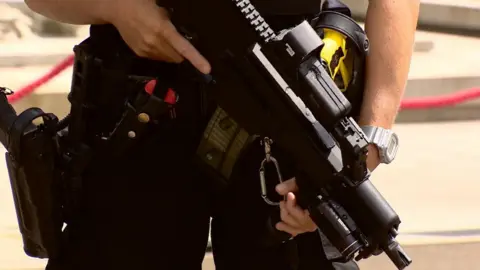Three-fold increase in children referred to anti-terrorism scheme
 Police Scotland
Police ScotlandThe number of Scottish children feared at risk of being drawn into terrorism has more than trebled in a year, new figures have revealed.
A total of 28 children under the age of 15 were referred to the Prevent de-radicalisation scheme last year, up from eight youngsters in 2016-17.
Police Scotland data reveals 104 people were identified as at risk of being exploited by extremists last year.
International and right wing extremism were the main concerns.
In about a third (35) of the 104 cases, it was found no further action was necessary, while two thirds (66) of referrals were passed on to other agencies such as social work. Three cases were identified as requiring ongoing Prevent programme intervention.
Assistant Chief Constable Steve Johnson, Police Scotland's lead for specialist crime and intelligence, said the increase in referrals could reflect a growing understanding and increased confidence in the Prevent scheme.
He said: "Police Scotland has a robust process in place to assess referrals and ensures that all individuals referred, irrespective of age, are provided with the support and safeguarding appropriate to their circumstances.
"Police Scotland works closely with partners to increase the awareness of Prevent and to enhance the ability of professionals and the public to recognise vulnerabilities that can lead to radicalisation."
Increase in cases
Schools and other public bodies are required by law to report people who show signs of being drawn into violent extremism as part of the UK government's counter-terror strategy.
This can be based on a person's actions, conversations, reading material or anything which is considered to be of concern.
Every time a case is referred to a Prevent panel, experts consider the evidence - such as a report from a teacher - and decide whether the individual needs to be steered away from extremist ideology.
Data from Police Scotland shows a total of 104 people, most of them male, were referred to Prevent in 2017-18, up from 59 in the previous year.
As well as increases in concerns over children, the number of teenagers (15 to 20-year-olds) referred to the scheme jumped from 23 to 34.
Referrals from the education sector increased from 13 to 40 over the same period.
 Getty Images
Getty ImagesThe main growth area of concern was "international extremism" which was the source of 38 referrals last year, up from 13 in 2016-17. Right wing extremism cases also saw an increase.
There were no concerns raised by local communities in 2017-18, down from eight such referrals the previous year.
Paul Thomas, professor of youth and policy at the University of Huddersfield and the co-author of a study into the Prevent programme's impact in schools and colleges, said: "The increase is not a surprise but it might also reflect the fact that many teachers are not entirely sure of what are grounds for referral and what is not, so refer anyway to be on the safe side.
"The difficulty for the education sector is very often it is not clear cut as to whether there should be concern over activity, what exactly is a genuine safeguarding issue and what is simply a young person exploring what is going on in the world around them."
Fresh questions were raised about Prevent after a wave of terror attacks hit the UK last year.
Last month the Intelligence and Security Committee said Manchester bomber Salman Abedi should have been considered for a Prevent referral after he was indentified by MI5 as a "subject of interest" in 2014.
Parsons Green attacker Ahmed Hassan was discussed at nine anti-terror referral panels, the last of which took place 10 days before he planted a bomb on a Tube train.